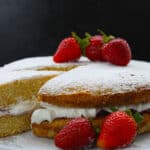Victoria Sponge Cake (No eggs, no butter)
My recipe for Victoria Sponge Cake is the perfect treat for any occasion. Sandwiched with whipped cream and jam, topped with a dusting of powdered sugar, it is elegant simplicity at its best. This version has all the amazing taste of the classic Victoria sponge, but it's made without eggs and butter.
Servings 8 slices
Ingredients
For the cake
- 1 ⅔ cups cake flour See note 1
- ¾ cup white granulated sugar
- 1 teaspoon baking powder
- ⅓ cup cornflour/cornstarch See note 2
- ¼ cup oil See note 3
- 1 cup milk
- 1 ½ teaspoon vanilla extract
- 1 teaspoon baking soda (bicarbonate of soda)
- 1 teaspoon white or grape vinegar
For the whipped cream filling
- 1 cup whipping / heavy cream
- ½ cup powdered sugar (icing / confectioners sugar)
Instructions
To make the cake
- Prepare the cake tins: Grease two 7 inches (20cm) round cake tins and line the bottoms with parchment paper.
- Sift your dry ingredients: Sift the flour, cornflour, baking powder, and sugar into a large bowl.
- Add the oil to the dry ingredients: Add the oil to the dry ingredients and beat with a whisk or electric mixer on low speed. Little clumps will form as you beat, this is okay, it's just the oil coating the dry ingredients.
- Pour in the milk and add vanilla extract. Beat on medium speed for one minute until the batter is smooth and free of lumps.
- Pour the vinegar into a small bowl and add in the baking soda. The baking soda starts to fizz and react as soon as it is mixed with the vinegar.
- Combine this immediately into your cake batter and beat for about 10 seconds.
- Transfer to your lined cake tins. Transfer the batter to your lined cake tins. The cakes should be put into the oven soon after beating in the vinegar and baking soda.
- Bake in the oven at 320°F/160°C for about 25-30 minutes or until a skewer or knife inserted in the center of the cake emerges clean.
- Let it cool in the tins for 10 minutes before transferring to a wire rack to cool completely.
To make the whipped cream filling
- Beat the cream in a bowl on medium speed for about 2 minutes or until stiff peaks form in the cream. Do not over mix, or it will ruin and separate the cream. Chill in the refrigerator until ready to use on the cooled cake.
- Transfer one cake to a serving platter, and spread jam evenly on top.
- Pipe or spread the whipped cream on top of the jam, then top with the remaining cake. Dust with powdered sugar and serve immediately or refrigerate until ready to serve.
Tips and frequently asked questions
Why is there oil used in this cake instead of butter?
- Since this cake is sandwiched with whipped cream, it is going to be stored in the refrigerator at some point. Cakes baked with butter tend to harden when refrigerated. These cakes lose their fluffy, tender texture.
- Baking with oil helps the cake keep that airy and light texture. It does not become heavy and dense when removed from the refrigerator. This is why I prefer using oil instead of butter especially in a cake which requires refrigeration
What causes the baked cake to become dense
- The main culprit causing a densely textured bake is overmixing.
- To avoid this, ensure that you mix all your ingredients at medium speed when using an electric mixer. If it is mixed on high or for too long, the cake batter loses the incorporated air and becomes dense.
How can I fix a dry, dense baked cake?
- All is not lost if you find that you over baked the cake. You can remedy it by brushing the cake with a simple syrup solution. This will fix the dry texture and add moisture to the bake.
- To make simple syrup, boil equal parts granulated sugar and water together until the sugar dissolves, then let it cool before brushing it onto the cake with a pastry brush.
What is the shelf life of this cake?
- At room temperature, this cake lasts up to one week when stored in an airtight container
Video
Notes
- It is best to use cake flour for this recipe as it produces a softer more tender bake, perfect for the light texture of this cake. However all-purpose or plain flour can be used as an alternative in countries where cake flour is not available.
- This should not be confused or mistaken with finely ground cornmeal that is used to make corn tortillas. Cornmeal has a gritty texture, while corn flour has a white chalky appearance and is very fine and smooth. Cornflour or cornstarch is used to thicken sauces and gravies or added to cakes and cookies to create a lighter bake. In this recipe, the cornstarch creates a light airy texture and produces an even tender crumb.
- Use a neutral-flavored oil like canola or sunflower oil
Nutrition
Serving: 1Slice | Calories: 402kcal | Carbohydrates: 53g | Protein: 5g | Fat: 19g | Saturated Fat: 8g | Trans Fat: 1g | Cholesterol: 44mg | Sodium: 216mg | Potassium: 91mg | Fiber: 1g | Sugar: 28g | Calcium: 88mg | Iron: 1mg
Tried this recipe?Mention @thegardeningfoodie or tag #thegardeningfoodie!
